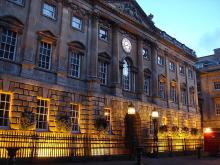Locations
Centrespace Gallery and Studios, Leonard Lane
Independent exhibition space and home to about 30 artists. Located in one of Bristol’s most ancient hidden lanes.
Read More »The Nails Market
Every Friday and Saturday on Corn Street and Wine Street 10am to 5pm. Local independent traders selling a fantastic array of gifts, from original artwork and photography to handcrafted jewellery and vintage clothing.
Read More »The Exchange
The Exchange is a Grade I listed building built in 1741–43 by John Wood the Elder, on Corn Street, near the junction with Broad Street in Bristol, England. It was previously used as a corn and general trade exchange but is now used as offices and St...
Read More »The Old Council House/Registry Office, Corn Street
Grade II listed building with many interesting features including a grand sweeping staircase.
Read More »St Nicholas Church, St Nicholas Street
The present church is probably the fourth building on this site. It is very close to the original quayside on the Avon, which explains the dedication to St Nicholas, the patron saint of sailors. The crypt of the church, built in about 1400, still remains...
Read More »Bristol Crown Court, Small Street
The present Crown Court opened in December 1993 on the site of Bristol's former main Post Office, retaining the overall style of the Post Office building. Currently it has ten courtrooms.
Read More »Bristol Book Market
The first Sunday of every month on Wine Street 10am until 4pm. This small but well-formed market offers customers the chance to hunt out their favourite authors, and browse the hundreds of titles on offer. This market was only launched in October 2010...
Read More »Christ Church
Probably the third church on this site, with regular services; re-built after demolition in 1786 – but going back to Norman times. The brightly coloured Quarter Jacks or Quarter Boys are a survival from the original church. Every quarter hour the figures...
Read More »St Stephen’s Church and Green,
Grade I listed ancient parish church of the city built in the 13th century with a 15th century landmark tower. Today home to an active spiritual community.
Read More »
